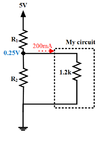bio_man
Full Member level 2
Hi folks,
USB provides 5V @ 500mA as we know, I want to get a 0.25V at 200mA using voltage divider as an input source to my circuit but the problem the input resistance of my circuit (Rin) is 1.2kOhms and I can not draw that much current in this case! any tips how can I make this simple source?
I attach a sketch for the circuit
USB provides 5V @ 500mA as we know, I want to get a 0.25V at 200mA using voltage divider as an input source to my circuit but the problem the input resistance of my circuit (Rin) is 1.2kOhms and I can not draw that much current in this case! any tips how can I make this simple source?
I attach a sketch for the circuit
